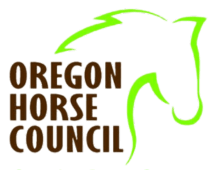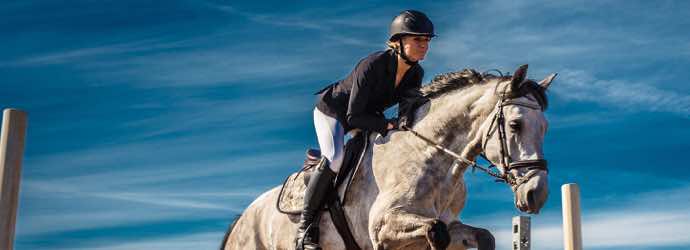Do you ever get confused by horse terms and wonder where they came from? If you don’t, we’re sure your non-horse friends are baffled by some of the words you use when talking about your beloved horse.
Here is a collection of some of our favorite horse terms and the history we were able to dig up on them.
Crupper: a strap from the back of a saddle passing under the horse’s tail. The crupper prevents the saddle from slipping forward. From what we found, this term originated around 1250–1300 and came from the Middle English cruper and Anglo-French crupere, which essentially means hindquarters.
Dressage: The International Federation for Equestrian Sports describes dressage as the highest expression of horse training, considered the art of equestrian sport, and is used as the groundwork for other disciplines. In this sport, the horse makes movements and maneuvers in response to body signals by the rider. The long and colorful traditions of dressage go as far back as Ancient Greece. The name used today, however, is thought to be more recent dating from around 1936 based on the French dressage, “to train, drill.”
Fetlock: you know that bunch of hair behind the pastern? The fetlock is actually the joint between the cannon bone and the pastern and literally translates to “foot-lock.” However, the term has early descriptions as a “tuft of hair behind the pastern-joint of a horse” in the early 14th century. This early emphasis on the “tuft of hair” may have been a misinterpretation. The Middle English suffix ok was misread and the word taken in folk etymology as a compound of feet and lock, where lock refers to a lock of hair.
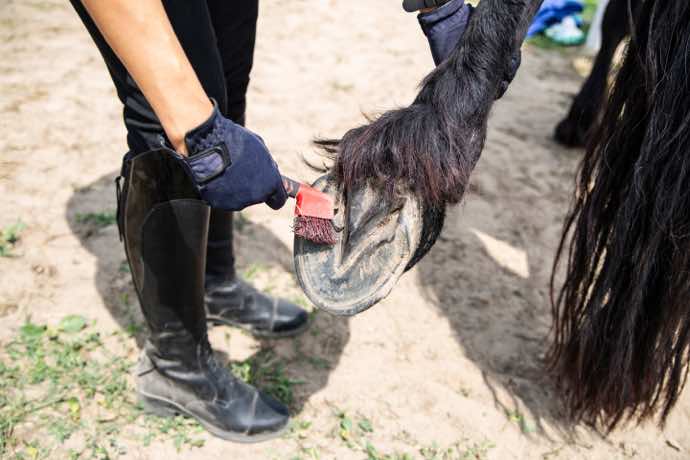
Frog: not to be confused with little colorful amphibians that jump, the frog is a part of a horse’s hoof, located on the underside, which should touch the ground if the horse is standing on soft footing. The frog is a triangular shape and extends mid-way from the heel toward the toe, covering around 25% of the bottom of the hoof. It turns out that ‘frog’ is simply the adaptation of Middle English frush (or forg or fursh), in French foursche, and in Latin furca. What all these words mean, is “fork.” It makes sense since the prominent feature of the frog on a horse’s hoof is the triangular shape that sits in the forked part of the hoof.
Thrush: bet you didn’t think research on the origin of frog would lead to thrush – because we sure didn’t! Interestingly, it seems the word “thrush” may also have its roots in the origin of frog. Originally called “running frush”, the hoof disease we now know as thrush was so named because it caused the “frush” (fork/frog) to “run” with puss. This later became “running thrush” and finally just “thrush.” The fact that it shares the same name as a human fungal infection seems to be coincidence. The term for human thrush shares its origins with the word “throat.” But perhaps this explains why people assumed that thrush in horses is also fungal, when it is most commonly a bacterial infection.
Gymkhana: a meet at which riders and horses display a range of skills and aptitudes. Likely originating around 1854, this Anglo-Indian term could be a mash-up gend-khana, literally “ball house,” and ahanam, “seat,” then altered in English by the influence of the word gymnasium.
Johdpurs: pants that are close-fitting, especially around the calves, so they fit inside tall riding boots. English style riders traditionally wear jodhpurs. Jodhpurs were initially loose and baggy around the hips and thighs, inspired by the Indian trousers called the churidar, or churidar pyjamas. Stretchy modern fabrics have resulted in tighter-fitting jodhpurs, often reinforced inside the knee and thigh. These pants are named after the Rajasthani Indian city of Jodhpur.
Lunging: (not to be confused with the exercise so many loathe their trainer for making them do) a type of exercise or training where the horse moves around you in a circle on the end of a lunge line. When done correctly, lunging can help a horse learn to be more flexible and balanced, as well as increase stamina. It can also be used to check a horse’s gait. We struck out on finding the origin of this term. Any ideas?
Barn Sour: refers to a horse that wants to stay at a physical location that represents security. This could be the barn, pasture, or other places, which represent the herd’s focal point for food, water and social interaction. While we don’t know where this term started, we can share that this is a type of separation anxiety. It is natural for a horse to be fearful of separation from his “safe place.” The horse is both prey and a herd species and prefers to remain in areas of comfort and with greater numbers. There is, of course, the occasional anecdote about a horse learning he won’t have to go to work if he stays in his barn. 😊
Hand: the linear measure of 4 inches (originally 3) is from the1560s. It was originally used for several types of measurements but now used only in giving the height of horses.
Did You Know? In the equine world, an animal measuring 14.2 hands at the withers and under is a pony. Any equine measuring more than 14.2 is a horse.
Poll: a name of the part of the head, alternatively referencing a point immediately behind or right between the ears. This area of the anatomy is of particular significance for the horse. Specifically, the “poll” refers to the occipital protrusion at the back of the skull. However, in common usage, many refer to the poll joint between the atlas and skull as the poll. The area at the joint has a slight depression and is a sensitive location. Thus, because the crownpiece of a bridle passes over the poll joint, a rider can indirectly exert pressure on the horse’s poll by means of the reins, bit, and bridle. Used in 14th century Middle English polle, meant “hair of the head; a piece of fur from the head of an animal.”
Star: a star references the small white marking on a horse’s forehead. A faint star may only appear as a few white hairs, or the star can be large enough it covers the whole forehead area. Stars can be very symmetrical in shape, like spots or diamonds, or they may appear as irregular splotches. No luck on the origin, but look at this little star.
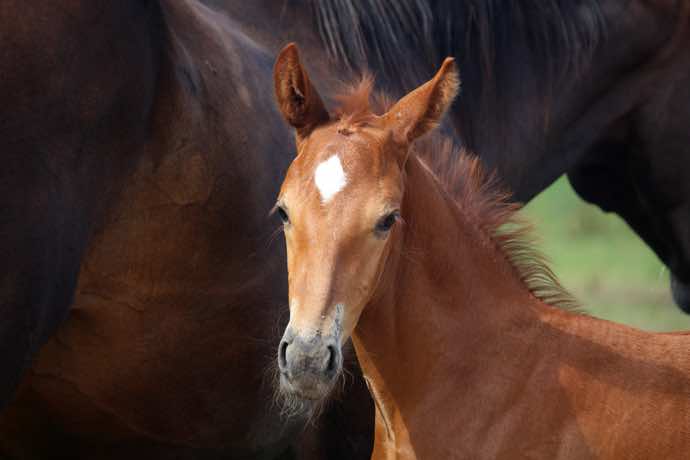
Sources:
https://www.etymonline.com/
https://www.vocabulary.com/
https://www.thesprucepets.com/horses-4162073
https://good-horse.com/blog/horses-frog-a-ribbeting-tale/
https://ihearthorses.com/15-horse-terms-that-really-confuse-non-horse-people/
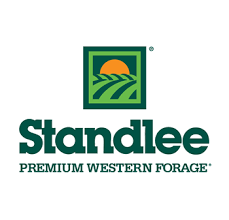
Standlee owns over 18,000 acres of carefully managed alfalfa, timothy grass, orchard grass, alfalfa/grass and orchard/alfalfa hay. Our facility in the small town of Eden, Idaho is 142,000 square feet. We have an extensive customer base both domestically and internationally. Standlee is a leader in the Forage industry. We continue to market and develop the highest quality products for our loyal customers “all year.”
